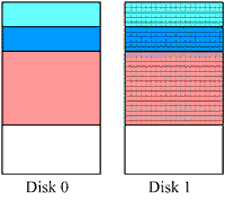RAID 1
RAID 1 is a true RAID level. Using the mirroring technique, it creates a mirror image of one hard disk drive on another hard disk drive. This provides data redundancy and increases the fault tolerance of the system. However, it is not designed to improve performance although performance is improved in some ways.
RAID 1 provides a faster access time and potentially faster read speeds which are somewhat offset by a huge hit in average write time. In short, RAID 1 provides a boost in read speed, a significantly faster access time but with a huge hit in write speed. This can be explained quite easily.
 |
With two hard disk drives containing the same data, their read heads can seek for different data blocks at the same time. Since each hard disk drive is actually independent, head seeks on both hard disk drives can occur simultaneously. Thus, the overall seek speed will be much faster than you would notice with just one hard disk drive.
Of course, reading a single file would only occur from one hard disk drive. But if the RAID controller is well programmed and optimized, it may intelligently use the other drives to satisfy other read requests.
The downside of the data redundancy provided by RAID 1 is that when you write to a RAID 1 array, the controller has to write the same data into both drives! So, instead of writing once, the system now has to write the same data twice. This effectively halves the writing performance of the RAID 1 array because the writes are not simultaneously written to both hard drives.
In RAID 1, the write completes on the first hard disk drive before it is written to the mirror. This was intentionally implemented to inhibit corruption due to bad disk sectors on the first hard disk drive. If a bad sector corrupts data, it won't get written to the second hard disk drive.
Now, is half the usual writing performance worth the data security provided by RAID 1? That depends on what you actually intend to use the system for and how critical is the data that resides in the system.
Having a mirror image makes it extremely easy for you to recover from a disaster. All you need to do is simply swap the defective drive with a new one. The data from the surviving hard disk drive will then be mirror-imaged into the new drive.
In addition, some RAID controllers support hot swapping through the use of hot swap bays. This allows a system to continue running while the defective drive is being swapped - a must for mission-critical systems that must absolutely remain running at all times.
Support Tech ARP!
If you like our work, you can help support out work by visiting our sponsors, participate in the Tech ARP Forums, or even donate to our fund. Any help you can render is greatly appreciated!
Page |
Topics |
|
|
1 |
|||
2 |
|||
3 |
• RAID 0 |
||
4 |
• RAID 1 |
||
5 |
|||
6 |
• RAID 5 |
||
7 |
|||
8 |
|||
9 |
|||
10 |
|||
11 |
|||
12 |
|||
13 |
|||
14 |
|||
15 |
|||
16 |
|||
17 |
|||
18 |
|||
19 |
|||
20 |
|||
21 |
|||
22 |
<<< RAID 0 : Previous Page | Next Page : RAID 0+1. JBOD, What's This RAID 5 We Keep Hearing About? >>>







 Add to Reddit
Add to Reddit
